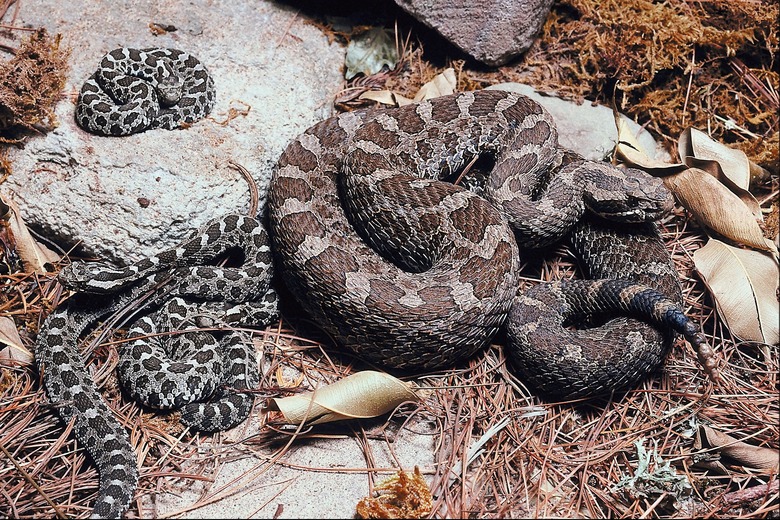What Do Rattle Snake Dens Look Like?
Rattlesnakes can pose a serious threat to human beings and other mammals because of their toxin, which is potentially deadly if left untreated. These creatures rarely bite, and the rattle from which they derive their name acts as a direct warning signal for other creatures to keep away. They congregate in dens during the winter months, and these dens can appear in most naturally occurring crevices. It can be hard to determine an area is a rattlesnake den unless it is occupied. Snakes gather in dens during the cold months to share body heat. The number of snakes per den varies depending on the climate of their locale and the amount of food available. If the region has an abundance of food and mild winters, dens can include few snakes, while in areas with little food and cold winters, these creatures huddle together in "balls."
TL;DR (Too Long; Didn't Read)
Rattlesnake dens can appear in most holes that occur naturally in stone. Any hole that provides adequate protection from the cold during winter could be a den. The dens can be difficult to identify unless snakes currently occupy them.
Where Snakes Sleep for the Winter
Where Snakes Sleep for the Winter
Rattlesnakes cannot burrow, so they rely on naturally occurring holes to act as a home during the winter months when the snakes hibernate. Small caves, gopher holes, rocky crevices and other such formations can act as homes for rattlesnakes during the winter. The area must be deep or otherwise protected to prevent dramatic temperature changes from affecting the hibernation. An unusually warm day, for example, can prematurely wake up the snakes, who will be sluggish and at heightened danger of depredation. Rattlesnakes can be found across North and South America, most often in rocky regions or near grasslands. During their active months, they can journey as far as 1.6 miles from their dens to their favorite hunting and basking areas.
How to Get Rid of Dens
How to Get Rid of Dens
Most governments do not consider rattlesnakes an endangered species, although some regional governments may have specific legislations surrounding killing them. Humans rarely die from their poison, and for the most part, the snakes lack aggression unless they are cornered or another animal gets too close. That said, they can appear in human settlements near their dens and pose a threat to livestock and children. Specialized traps, including glue traps, exist that can be placed outside a den to capture the snakes as they wake up from hibernation. A shotgun can also work, though that approach seems cruel. Dynamite has obvious drawbacks in that it's hard to determine how many of the snakes die after its use, and it also comes with a good amount of danger for the user. Pouring gasoline into a den can draw the snakes out where they can be dealt with from a distance. While rarely protected by laws, rattlesnakes play an important role in their ecosystems keeping prey populations at bay. If at all possible, nonlethal deterrent measures should be used.
Cite This Article
MLA
Johnson, Doug. "What Do Rattle Snake Dens Look Like?" sciencing.com, https://www.sciencing.com/do-snake-dens-look-like-6370802/. 30 April 2018.
APA
Johnson, Doug. (2018, April 30). What Do Rattle Snake Dens Look Like?. sciencing.com. Retrieved from https://www.sciencing.com/do-snake-dens-look-like-6370802/
Chicago
Johnson, Doug. What Do Rattle Snake Dens Look Like? last modified March 24, 2022. https://www.sciencing.com/do-snake-dens-look-like-6370802/
